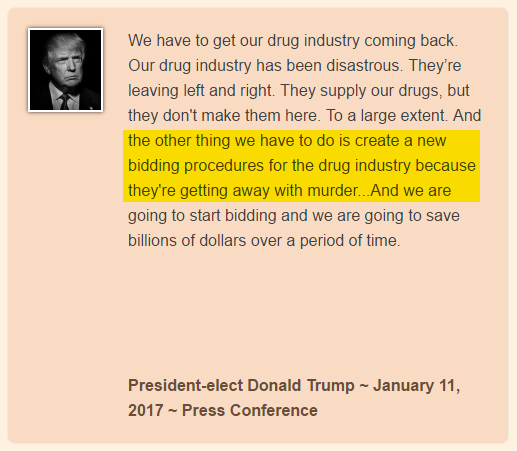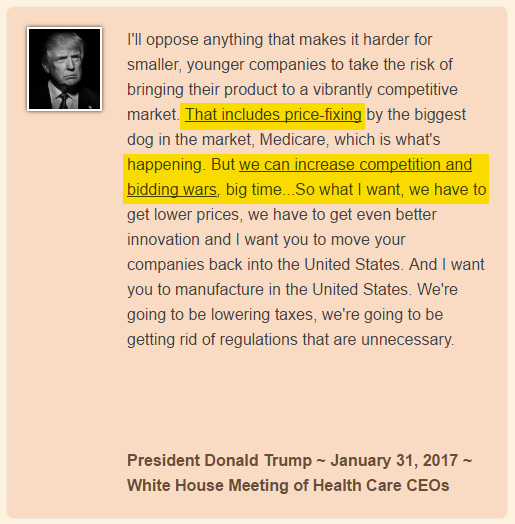Biotechnology: Poised To Head Higher
Biotechnology sector was one of the worst performing ones in 2016, with a decline of -21% as represented by the Nasdaq Biotechnology Index ETF (IBB). While the rest of the market has sailed away, with the broader indexes Nasdaq (QQQ) and S&P 500 (SPY) continuing to set new all-time highs, the Biotech industry has been caught in a regulatory spiral and the sector valuation has been trading in a range for the past year.
The Republican control of both the White House and the Congress, following the November elections, created a relief rally for the biotechs and pharmaceuticals as the possibility of any price-negotiating regulation, for the Medicare and Medicaid programs, appeared remote. The rally was short-lived as subsequently, President Trump, on multiple occasions, indicated his focus on bringing down prices and allowing government agencies to negotiate.
One such instance was in January when he went off-topic and took his first press conference post-elections to indict the pharmaceutical and biotech industry of murder.

This led to an industry summit at the White House, attended by CEOs of some large pharmaceutical companies. Commentary coming out of the summit quoted the President as saying:

The statement was ambiguous for it showed support for the industry position of no price setting by the government, as well as support for competitive bidding, a position that the industry shuns. The ambiguity indicated that there is a split in Trump's position and he may be amenable to the current law, supported by the industry and Republicans, of no bargaining by the Center for Medicare and Medicaid. At the same time, the President has indicated that he will do much to streamline the drug approval process. This would suggest faster timelines, which in turn can reduce drug approval costs. Many of the points we had raised in an earlier article, Can Trump Be A Catalyst, have become relevant in the new dynamic. Even though the following week the White House press secretary indicated continued support for competitive bidding, it appears that both the industry and investors have realized that this is all the regulatory clarity that will be achieved for some time, and it is sufficient clarity to move on with the plans. Consequently, an industry and investor sentiment shift is occurring.
Biotech has been at an inflection point with a number of key positives bubbling up, but the sector was being tied up by regulatory uncertainty. This uncertainty appears to be diminishing. We have believed for some time that the sector is building sufficient momentum to achieve 52-week highs and thereafter build further on gains, as discussed in our earlier article Biotechnology: Ready for New Highs.
In our opinion, the Trump administration would seek concessions from the industry without changing regulations, and this is the new reality that the industry and the stock market appears to be adjusting to. For the first time, the sector took the most recent example of an egregious price increase by Marathon Pharmaceuticals, for a steroid Emflaza, in its stride without retreating, even though the incident has sparked political pressure and pushback.
Push Towards Consolidation
The pharmaceutical industry has an even greater focus on innovation now, as frequent and large price increases are no longer a viable growth strategy in the present environment. This exacerbates the pressure on large pharmaceutical companies to add new product lines that can boost revenues in the future.
One way to drive innovation is to purchase it. In 2017, we will witness a much stronger pace of Mergers & Acquisitions (M&A) compared to 2016. Throughout last year, the Biotech industry had been advancing its programs and achieving or approaching key milestones, while sector valuations eroded, thus making the sector more attractive for larger biotech and pharmaceutical companies to find targets. The thesis of a consolidation push was discussed in greater detail in an earlier posting, Can Trump Be A Catalyst For M&A.
There has already been a spurt in M&A activity in 2017 with Takeda Pharmaceuticals acquiring Ariad Pharmaceuticals (ARIA); Eli Lilly's (LLY) acquiring Collucid Pharmaceuticals (CLCD), a firm which ironically started a few years ago with its only drug candidate purchased from Eli Lilly; Johnson & Johnson's acquisition of Swiss drugmaker Actelion; and Intrexon's (XON) acquisition of Genvec (GNVC), to highlight a few transactions.

Conclusion
We believe Biotech is poised to make new 52-week highs on the benchmark Nasdaq Biotech index, which is large-cap weighted, and S&P Biotech Select (XBI), which is more heavily weighted towards mid-cap and small-cap stocks and shall benefit the most from M&A support. We anticipate biotechnology valuations will continue to make good progress thereafter, at least in the first-half. The year has already started strongly with a 5% gain in January for the Nasdaq Biotech index, while the 8-stock Prudent Biotech Portfolio leaped 14% for the month. Reflecting our belief in a valuation expansion, earlier this month we increased our allocation to the Biotech sector in our Graycell Small Cap Portfolio, which had gained +71% in 2016, to a higher level than at any time earlier over the past 12 months. There are a number of promising biotech stocks, and the best approach that has served us well is to have a growth portfolio of small caps and mid caps.
Over our past postings, we have mentioned a number of promising names. Ariad Pharmaceuticals and Colucid Pharmaceuticals have both been acquired. Some other promising names that we have mentioned include, Tesaro (TSRO), Exelis (EXEL), Clovis Oncology (CLVS), Acadia Pharmaceuticals (ACAD), Array Biopharma (ARRY), Achaogen (AKAO); Momenta Pharmaceuticals (MNTA), Portola Pharmaceuticals (PTLA), Exact Sciences (EXAS), Loxo Oncology (LOXO), Aerie Pharmaceuticals (AERI), Synergy Pharmaceuticals (SGYP), and large-cap Incyte Pharmaceuticals (INCY). Biotech exposure can also be acquired through ETFs like iShares (IBB) and S&P Spdr (XBI), and leveraged ETFs like Direxion S&P Bull (LABU) and Direxion S&P Bear (LABD).
As always, kindly do your own due diligence.



